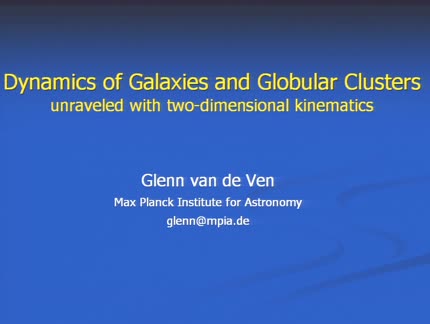Found 14 talks width keyword galactic classification

Abstract
Two-dimensional stellar kinematics obtained with the integral-field spectrograph SAURON allow the classification of early-type galaxies into 'slow' and 'fast' rotators, different from their morphological classification into ellipticals and lenticulars. Most fast rotators, including lenticular as well as many elliptical galaxies, are consistent with oblate axisymmetric disk-like systems. On the other hand, the slow-rotator ellipticals show clear deviations from axisymmetry, which can be modeled with our extension of Schwarzschild's orbit superposition method to triaxial geometry. Besides galaxies, I show that Schwarzschild's method can also be used to model in detail globular clusters such as ω Cen and M15. The recovered internal orbital structure of ω Cen reveals besides a signature of tidal interaction, also a central stellar disk, supporting its origin as the nucleus of a stripped dwarf galaxy. The formally best-fit Schwarzschild model for M15 includes an intermediate-mass black hole, but we cannot exclude a model in which dark remnants make up the dark mass in the collapsed core.

Abstract
Using the k-means cluster analysis algorithm, we carry out an unsupervised classification of all galaxy spectra in the seventh and final Sloan Digital Sky Survey data release (SDSS/DR7). Except for the shift to rest-frame wavelengths and the normalization to the g-band flux, no manipulation is applied to the original spectra. The algorithm guarantees that galaxies with similar spectra belong to the same class. We find that 99% of the galaxies can be assigned to only 17 major classes, with 11 additional minor classes including the remaining 1%. The classification is not unique since many galaxies appear in between classes; however, our rendering of the algorithm overcomes this weakness with a tool to identify borderline galaxies. Each class is characterized by a template spectrum, which is the average of all the spectra of the galaxies in the class. These low-noise template spectra vary smoothly and continuously along a sequence labeled from 0 to 27, from the reddest class to the bluest class. Our Automatic Spectroscopic K-means-based (ASK) classification separates galaxies in colors, with classes characteristic of the red sequence, the blue cloud, as well as the green valley. When red sequence galaxies and green valley galaxies present emission lines, they are characteristic of active galactic nucleus activity. Blue galaxy classes have emission lines corresponding to star formation regions. We find the expected correlation between spectroscopic class and Hubble type, but this relationship exhibits a high intrinsic scatter. Several potential uses of the ASK classification are identified and sketched, including fast determination of physical properties by interpolation, classes as templates in redshift determinations, and target selection in follow-up works (we find classes of Seyfert galaxies, green valley galaxies, as well as a significant number of outliers). The ASK classification is publicly accessible through various Web sites.

Abstract
This talk is divided into two related parts. First, we will call your attention to a basic, but often overlooked worrying fact, and presents ways of dealing with it. The fact is: an enormous number of galaxies in surveys like the SDSS have emission lines which are too weak (low S/N) to be classified by usual schemes (ie, diagnostic diagrams). It turns out that most of these are AGN-like, so ignoring them on the basis of low S/N (which most people do) leaves as much as 2/3 of these emission line galaxies unaccounted for. The solution: We present a number of alternative methods to rescue this numerous population from the classification limbo. We find that about 1/3 of these weak-line galaxies are massive, metal rich star-forming systems, while the remaining 2/3 are more like LINERs. In the second part, we revisit the old idea by Binette et al (1994) that post-AGB stars can account for the emission line properties of some galaxies. A "retired galaxy" model is presented and compared to data in the SDSS. We find that about 1/4 of the galaxies classified as LINERs in the SDSS are consistent with this model, where all ionizing radiation is of stellar origin. More dramatically, nearly 100% of weak-line LINERs are perfectly consistent with being just retired galaxies, with no active nucleus. If these ideas are correct, contrary to current practice, relatively few LINERs should be counted as bona fide AGN.
Abstract
The SAURON survey has revised our view of early type galaxies discovering that central disks and multiple kinematic components are common; 75% of the sample have extended ionized gas, often misaligned with the stars; half of S0s and 25% of Es have intermediate age populations. There is a tight relationship between the escape velocity and Mg line strength which holds both within and between galaxies raising uncomfortable questions for hierarchical assembly. Many of the properties of ETGs are related to a measure of their specific angular momentum : slow rotators are triaxial, close to spherical, isotropic and frequently exhibit decoupled central kinematics, whereas fast rotators are intrinsically flatter, oblate, have disk-like (anisotropic) kinematics and often have Mg enhanced disks. In general the slow rotators are more massive and have older populations Only half of the elliptical galaxies exhibit slow rotation, the remainder have stellar disks showing that the historic division by morphological class is physically misleading. We suggest that the contrasting physical properties of fast and slow rotators arise through distinct assembly histories with slow rotators forming in gas free, dry mergers and fast rotators retaining a disk component through a dissipative merger.<< First « Newer 1 | 2 Older »
Upcoming talks
- ML x Cosmology with 50 Million GalaxiesDr. Changhoon HahnTuesday May 7, 2024 - 12:30 GMT+1 (Aula)
- Unveil the Composition and the Origin of Primitive Asteroids through Sample-Return MissionsDr. Tania LepivertTuesday May 14, 2024 - 12:30 GMT+1 (Aula)









